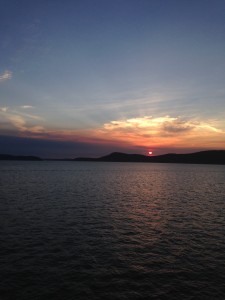I had made my way to my last destination in the Pacific Northwest – Friday Harbor Labs. I had been invited out by Pema, the DSO for the Labs. She was one week into a 5 week Scientific Diving course and wanted any extra help, so I figured it would be a great opportunity for me – I would go out and get to assist with the course and see another way to teach AAUS Scientific Diving and Pema would have another set of hands to help the students. After getting in Sunday evening, I had a quiet and early night, because Pema was putting me right to work the next morning.

I met with Pema at 7:45 am at the dock on Monday morning to get a dock orientation and get my gear put away in my locker. I would then be meeting up with Katie, a PhD student at the labs who was out doing a research project and who had offered to take me on a dock orientation dive. We splashed in the water right around 9 am and did a nice tour of the pier, exploring the pilings, clump weights, and eelgrass bed. It is such a cool dock dive – tons of invertebrate life (including heaps of neat nudibranchs) and it’s also a perfect setting for training students, with a sand bottom and little current. After a nice little dock tour, we surfaced and I went up for what I thought would be a nice long lunch.
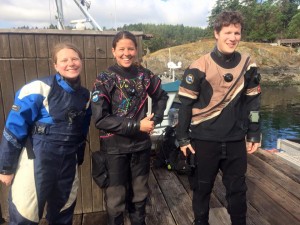
But about 10 minutes after being back at my cabin I got a text that I could jump on a collection dive leaving at noon. I never say no to more dives, so I packed a quick lunch and ran back down to the dock to get my gear ready. I was joining a visiting professor who wanted to collect some Armina and Tritonia nudibranchs for his research. We headed out to a sea pen bed, where he knew the Armina species were plentiful and hopped in the water. We descended to the bottom and started hunting, grabbing the fat little nudis and putting them into goodie bags to take back to the boat. After about 25 minutes of being hunter/gatherers, we surfaced with plenty of the slugs and made our way back to the labs. After scarfing down my lunch, I was slated to do one more dive that afternoon with Alex, one of the TAs for the Scientific Diving course. The class had set out a series of 36 PVC pipe tubes with various substrate inside to see what would collect/congregate in what zonation (intertidal v. subtidal). Alex and I had a task-heavy dive ahead of us. We had to snip the zip tie holding a set of 2 tubes to a stake, place individual tubes in labeled bags, collect rebar stakes, and record the tube number with depth. Our hands were definitely full, but we got into an efficient rhythm and started getting work done fast! We managed to successfully collect all 36 tubes with no incident and surfaced to the boat. We got back to the dock and some students came down to help drain/sort the tubes and I rinsed off gear and headed up to make dinner. It had been a BUSY first day, but I was off to a great start! Pema had done an awesome job making sure I had plenty of diving to do and I was looking forward to the rest of my time with the labs. That evening a group of professors and graduate students and I met for dinner at one of the professors’ cabins. He had a huge bounty of Dungeness crab, so we chowed down on fresh crab, homemade pizza, and locally distilled gin. What a way to spend my first full day at Friday Harbor Labs!
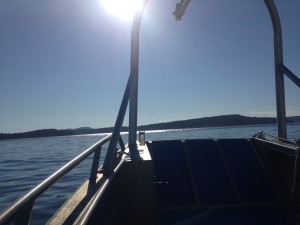
Tuesday was a scheduled pool training day for the class – part of the course was doing the Rescue Diver cert – so they had booked some pool time to work on various skills in a controlled environment. We packed up the vans and headed to the private pool, where we got our gear unloaded and up to the pool house. We had left one of the van’s back doors open, which happened to have everyone’s sack lunches inside (remember this little fact). Thinking nothing of it, everyone crowded into the indoor pool, getting gear set up and then students started their day off with a swim test, which everyone passed. We then kitted up and all hopped into the “heated” pool. I assumed that I’d be warm in the 80 degree water, but I was sure wrong. About 10 minutes into the day, I was shivering and so cold. I guess I have no capability to thermoregulate anymore. But I sucked it up and kept on with the skills. Pema led the class through a variety of demonstrations for things such as rescue breaths at the surface, removing gear and giving rescue breaths, bringing up an unconscious diver from depth, and egresses. Everyone worked in buddy pairs to practice the skills and it was really good for me to go over the rescue skills again. It’s amazing how rusty you get when you don’t practice certain skills regularly. Pema kept asking me to play the victim for the rescue drills, but I loved doing it – just going limp and not helping the rescuer at all is the best way to teach people what it’s really like to rescue and deal with an unconscious person. After a few hours of drills and practice, we broke for lunch. A few of us walked out into the sun only to be met with a scene of horror – the 2 residential goats on the property had found the sack lunches and proceeded to pull one out and strew the contents all over the ground. The funniest part was they singled out only one lunch, Alex’s, and the rest were left untouched in the trunk. The goats had spitefully trashed poor Alex’s lunch, and they didn’t even eat any of it! Just threw it on the ground and wasted it. Everyone was willing to share their lunch and we didn’t let the mischievous goats get us down. Derrick, one of the dive instructors was quick to point out that all divers owe goats. Why? Because in the 60’s, when not much was known about DCI and the bends, physicians experimented on goats in hyperbaric chambers and came to develop much of the modern day dive tables. It is because of goats that we, as divers, know our No-Deco Limits and can safely dive following our tables. Alex’s lunch became our homage to the past goats who advanced the safety of divers.
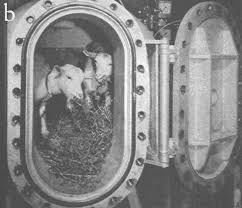
After lunch, we hopped back in the pool to put all the rescue skills and practice into a scenario in which you find an unconscious dive on the seafloor and safely surface and get them out of the water. After about an hour or so of this practice, I hopped out early with one of the graduate students, Mo, to head back to the labs to help Katie with a dive. After another quick lunch, I was back down at the dock and ready to help Katie. She needed to lay out a series of eight 2x2m squares, where she would be conducting a study on kelp recruitment over the next several months. We loaded the boat with all our gear and equipment, took a short ride over to her study site, and were in the water in short time. We got right to the task – after finding the bundles of brick and rope that Katie had assembled and neatly tied up, we took one at a time and spread it out to form a nice 2x2m square on the rocky substrate. After powering through all 8 squares, we ascended and were met by Mo with the boat. It had been another jam-packed day of scientific diving, but I was sure glad to be put to good use.
Wednesday we met at 7 am at the dive locker to get an early start to the day. I met with Alex and Aaron, who wanted to put out a skills course of sorts, to get the students practicing compass-based navigation and transect use. We planted some PVC pipes based on prechosen headings (to act as start and end points) then sprinkled a predetermined transect with “special creatures” (laminated pictures of the students and staff from the course, as created by Alex) the students would have to identify and practice counts on. After laying out the course and doing it once ourselves to make sure everything was in the correct position, we headed back up. The students all arrived at 8:30 and after giving them a brief drill in using a compass, they got their gear ready to dive and divided into 3 groups. Aaron led one group, and after giving them the instructions and headings, they geared up and hopped in the water. Alex and his group started once Aaron’s surfaced, and I started with the last group as Alex surfaced.
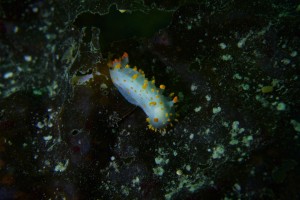
We finished around lunchtime and after rinsing gear, headed up to eat then ran over to the classroom at 1pm to sit in on the UW boating orientation. We spent an hour or so in a lecture on all the boating procedures for UW and take a small test to be approved to boat tend. We then headed to the dock to be familiarized with the 4 boats we may use during our research and split up in two groups to head out and practice driving. It was a beautiful sunny day and we had a lot of fun driving around the area, practicing reversing, pulling up to divers/objects in the water, and just playing around with the boats. As we turned back to the labs to practice docking, a girl on my boat yelled that she spotted a whale! We all peered around but saw nothing after a few moments. Then suddenly! A quick peek at a dark back and small blowhole. “Whale?” I thought, “No, that’s just a harbor porpoise.” But the second time it broke the surface, we could clearly see the long, dark back, small dorsal fin, and white patches characteristic of a minke whale! And it had surfaced barely 50 feet from our boat before darting back under and continuing its travels. It had been a brief and unexpected encounter, but amazing nonetheless. After spending a bit of time with docking practice, we offloaded and headed back up for dinner. After dinner was the weekly lecture series, which was featuring two scientists and their current research. A lot of students and professors attend these lectures so it’s a great place to learn about ongoing research in the Pacific Northwest as well as meet other folks at the labs.

Thursday I was given the chance to sleep in, as the class had a field trip and not enough room for me to tag along. Instead, I attempted to catch up on sleep and then worked to get caught up on blogs and emails. It was a quiet but productive morning for me and by afternoon, I was quite ready to meet up with the class and get diving. They were scheduled to do more rescue practice, but this time doing all the skills from Tuesday in the ocean and in drysuits. A few other UW staff had joined to practice their rescue skills and Pema had invited a few other DSOs to come help with the drills. I was originally assigned to be a rover, going around underwater, watching and making sure the groups were ok, helping out if needed. However, after 10-15 minutes of swimming around, I realized that I wasn’t really needed so I surfaced to provide dock support. One of the DSOs was given the glorious title of “Dock Queen” and he would act as surface support to the groups as they surfaced with their practice victim, egressed onto the boats and administered oxygen. With two boats being used and 6 groups running drills, the Dock Queen had found himself quite busy so I quickly stripped down my gear and took the informal role of “Dock Princess” helping on one boat with the drills to lighten the load. After everyone had the chance to practice a full rescue, we put away gear and met for a debriefing to discuss the practice. By this time, everyone was hungry so a group of us went out to grab dinner at a nearby restaurant and swap stories of scientific diving as well as discussing what it takes to be a DSO at various institutions.
Friday morning started off with some practice eelgrass surveys for the students to do off the dock. They were tasked with designing and implementing a survey method to determine percentage coverage of an eelgrass bed. This would get them thinking about setting up and conducting a survey from start to finish as well as learn how to determine sound scientific methods to get the best results. I was paired with one team to serve as the Dive Leader (because they were not certified scientific divers, they still needed someone who was to accompany them on dives). My team was assigned a region of the bed to survey and after going over the survey plan once more, we suited up and hopped in the water. We spent about 35 minutes surveying at 3 depths and then surfaced, satisfied with the way the assignment went. After a debriefing with the entire class about everyone’s approach, we broke for lunch and a small break before the final rescue drills that afternoon. We met up around 2:30 at the dive locker and casually waited around. Pema had earlier sent out an email to the visiting DSOs, myself, and some of the UW divers who would be acting in the 2 rescue drills. She had outlined two different scenarios that would overlap to get all the students engaged and participating in the drill. I was paired with Chris (PhD student), Nate (DSO), and Alan (DSO). Our scenario was this: we had left to do a dive to observe some tunicates on the clumpweights and when Nate signaled he was low on air, we began swimming back to the dock to get up on the boats. At some point, we lost Nate while swimming back and we surface, worried about where our dive buddy was and at that point, the students would engage in a search and rescue procedure. I decided beforehand that I wasn’t going to make it easy and would play the role of the highly distressed and aggravated dive buddy who was extremely worried about her lost diver. While the students had become engaged with the first rescue scenario, the four of us slipped unnoticed into the water and began to get in place for our drill. We did swim out to the clump weights and as we were heading back in, left Alan and Nate right off the edge of the eelgrass bed. Chris and I surfaced a ways off the dock and begun shouting for help. Chris played it cool as a cucumber, but I hammed it up to add a realistic air to the scenario and get some adrenaline rushing in the students. We went through the whole drill (me acting a drama queen the whole time) and in just about 16 minutes the students had recovered, egressed, and begun oxygen administration on the poor lost Nate. The drills had been completed with speed and efficiency, and we gathered for a thorough debriefing of the drills, going over all the positives, recommending some small changes in procedures, but overall, the students performed exceedingly well. After the debrief, we headed up to the dinning hall to have a few drinks and popcorn at the weekly “TGIFHL” that is hosted every Friday to encourage people on campus to mix and mingle. From there, the students invited me and Alex to come to a small get together they were having at one of the girl’s house off campus to celebrate all the hard work of that week. It was a gorgeous night with a huge, blue moon and I enjoyed my time getting to know the students better.
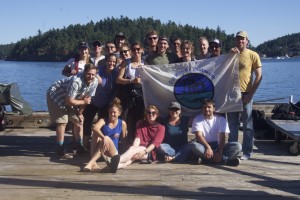
Saturday we got started so bright and early! Pema had arranged for a field trip to the mainland. We would first stop at the site Padilla Bay, where Alex was doing most of his graduate work on oysters and then we would head down to Seattle to take a tour of the Virginia Mason Hyperbaric Chamber. We met at 7 am to carpool in campus vans to the ferry terminal, where we’d take the ferry over to Fidalgo Island and drive to Padilla Bay. We spent a few hours, talking about the ecology of that intertidal, estuarine zone and walking along the mudflats, looking at eelgrass, sponges, and oysters.
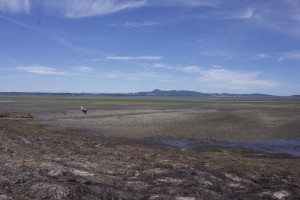
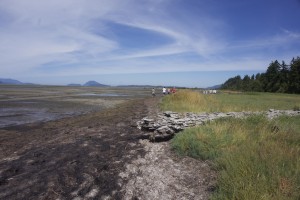
Alex lectured the students on the ecology of the zone and his research. Around noon, we headed back to the vans to get packed up and headed down to Seattle. We managed to dodge traffic and made it into the city in excellent time. We were met at the hospital by one of the hyperbaric nurses, who would be leading our tour for the afternoon. We got an awesome tour of the facility, from the history of the chamber to common uses and dive accidents they’ve seen. The tour made me realize, as my 4th chamber I’ve visited, I have an interest in learning even more about hyperbaric medicine and potentially learning how to run a chamber (if the opportunity arises in the future). After about 2 hours of looking around, learning, and asking questions, we thanked the nurse and started the long journey back to Friday Harbor. We stopped in Anacortes for dinner (which ended up being a fiasco as we overwhelmed the restaurant and almost missed our ferry) but made it safely back to Friday Harbor by the night.

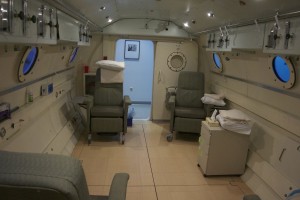
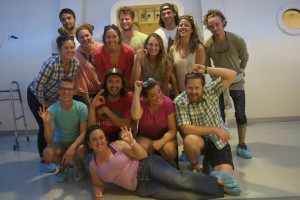
I went to Friday Harbor Labs not really knowing what to expect during my time, but found myself roped into a week jam-packed with fun and diving (2 of my favorite things). I found myself engaged in a variety of work, from the scientific diving class to an assortment of research projects as well as meeting all sorts of incredible and interesting people. I was very happy I made the choice to extend my trip at the labs for another week– I wasn’t quite ready to leave!
